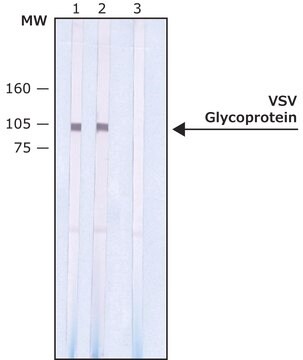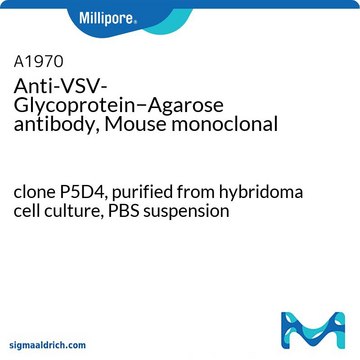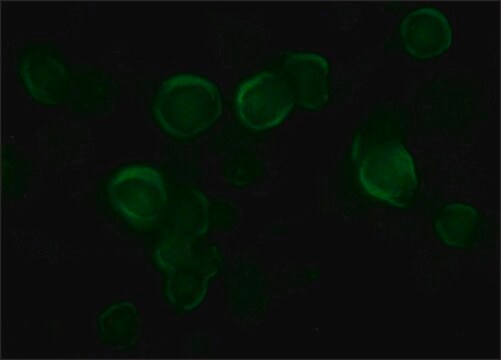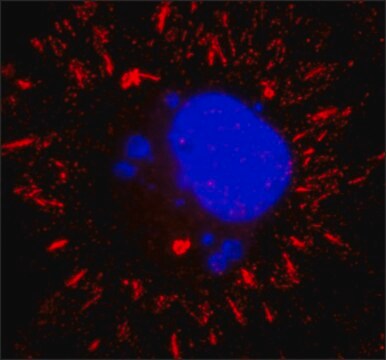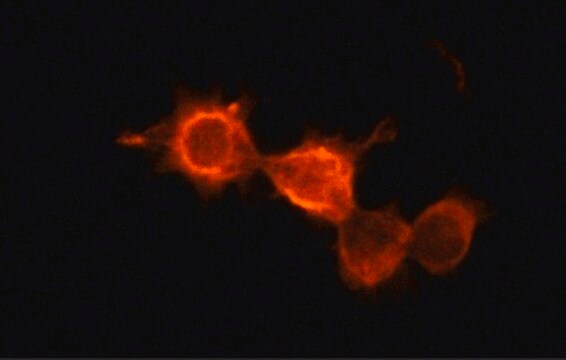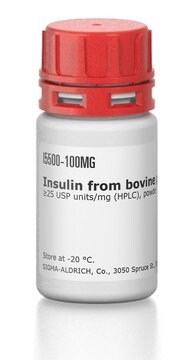Opis ogólny
Monoclonal Anti-VSV-G-Peroxidase jest liofilizowanym preparatem oczyszczonej frakcji immunoglobulin monoklonalnych Anti-VSV-G (izotyp mysiej IgG1) wyizolowanej z płynu puchlinowego hybrydoma P5D4, sprzężonej z peroksydazą chrzanową (HRP). Przeciwciało pochodzi z hybrydomy P5D4 wytwarzanej przez fuzję mysich komórek szpiczaka i splenocytów myszy BALB/c immunizowanych syntetycznym peptydem. Glikoproteina wirusa pęcherzykowego zapalenia jamy ustnej (VSV-G) występuje jako trimer i składa się z czterech domen, wśród których domena III jest domeną homologii pleckstryny (PH).
Specyficzność
The antibody recognizes an epitope containing the five carboxy-terminal amino acids of VSV Glycoprotein. In infected cells, the antibody localizes the immature forms of VSV-G in the rough endoplasmic reticulum (RER) and in the cisternae of Golgi complex, as well as mature VSV-G at the cell surface and in the budding virus. The antibody does not stain the secreted form of VSV-G which lacks the membrane and the cytoplasmic domain. This antibody has been used for studies on the role of the cytoplasmic domain on newly-synthesized VSV-G during transfer to the plasma membrane and cell surface, using micro-injected antibody, immunoblotting, immunoprecipitation, immunocytochemistry and immunoelectron microscopy. The antibody has been used for the detection, immunoprecipitation and immunocytochemical staining of exogenously introduced constructs tagged with the carboxyl-terminus of VSV-G. This tag does not interfere with the function of the studied protein and can be specifically recognized by the P5D4 antibody without cross-reaction with any endogenous protein.
VSV-G tag sequence (YTDIEMNRLGK) on VSV-G tagged fusion proteins when expressed N- or C-terminal to the fusion protein. Recognizes native and denatured forms of VSV-G tagged proteins.
Immunogen
synthetic peptide containing the 15 carboxy-terminal amino acids (497-511) of Vesicular Stomatitis Virus Glycoprotein (VSV-G), conjugated to KLH.
Zastosowanie
Monoklonalne przeciwciało anty-VSV-G-Peroxidase wytwarzane u myszy może być stosowane do immunoblottingu.
Działania biochem./fizjol.
Sekwencja aminokwasowa glikoproteiny wirusa pęcherzykowego zapalenia jamy ustnej (VSV-G) YTDIEMNRLGK, odpowiadająca aminokwasom 501-511, jest szeroko stosowana jako znacznik epitopowy w wektorach ekspresyjnych, umożliwiając ekspresję białek jako białek fuzyjnych znakowanych VSV-G. Stanowi on atrakcyjny model do badania dojrzewania i wewnątrzkomórkowego transportu białek błonowych. VSV-G pośredniczy w przyłączaniu VSV do powierzchni komórki i indukuje zależną od pH fuzję między błoną wirusową i docelową. Poza tym jego domena cytoplazmatyczna zawiera informacje dla kilku etapów sortowania wewnątrzkomórkowego, które obejmują wydajny eksport z retikulum endoplazmatycznego, dostarczanie podstawno-boczne i endocytozę..VSV-G jest transportowany przez stosy w cysternach Golgiego.
Postać fizyczna
Dostarczany jako liofilizowany proszek. Po odtworzeniu roztwór zawiera 1% BSA i 0,05% MIT w 0,01 M soli fizjologicznej buforowanej fosforanem sodu, pH 7,4.
Rekonstytucja
Po rozpuszczeniu w 0,5 ml wody uzyskuje się roztwór 0,01 M soli fizjologicznej buforowanej fosforanem sodu, pH 7,4, zawierający 1% BSA i 0,05% MIT.
Przechowywanie i stabilność
Przechowywać liofilizowany produkt w temperaturze 2-8 °C. Po rekonstytucji, w celu przedłużonego przechowywania, zamrozić w podwielokrotnościach roboczych w temperaturze -20 °C. W przypadku ciągłego stosowania roztwór można przechowywać w temperaturze 2-8 °C przez okres do 1 miesiąca. Rozcieńczenia robocze należy wyrzucić. Unikać wielokrotnego zamrażania i rozmrażania.
Oświadczenie o zrzeczeniu się odpowiedzialności
O ile nie określono inaczej w naszym katalogu, nasze produkty są przeznaczone wyłącznie do użytku badawczego i nie mogą być wykorzystywane do żadnych innych celów, w tym między innymi do nieautoryzowanych zastosowań komercyjnych, zastosowań diagnostycznych in vitro, zastosowań terapeutycznych ex vivo lub in vivo ani do żadnego rodzaju konsumpcji lub stosowania u ludzi lub zwierząt.
Ta strona może zawierać tekst przetłumaczony maszynowo.
